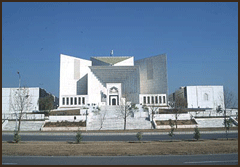Supreme Court of Pakistan Lifts Kite Flying Ban for Fifteen Days
 Responding to several petitions to lift a ban on kite flight for the holiday period in Pakistan, the Supreme Court decided to temporarily permit kite flying for fifteen days. During this period, the activity will be monitored to determine if safety conditions have improved.
Responding to several petitions to lift a ban on kite flight for the holiday period in Pakistan, the Supreme Court decided to temporarily permit kite flying for fifteen days. During this period, the activity will be monitored to determine if safety conditions have improved.
Pakistan has been troubled by many serious kite injuries and even deaths of kite fliers during the Spring holiday periods. Most of this is due to two factors: -injuries sustained by the kite flyer during the flight of the kite (falling off roof tops, wandering into automobile traffic, etc.) and -injuries sustained from the glass and chemically coated kite lines used in kite fighting during the holiday periods. In addition, serious power blackouts causing economic disadvantage have been frequently caused by the kites and lines creating shorts in the power grid. Some kiters have also been electrocuted trying to rescue kites in power lines.
While the lifting of the ban on flying is temporary, the regulation against using glass coated line, known as Manja, remains in effect.
At the end of the fifteen day period the issue will again be revued by the Court.
From: The Daily Times - Lahore, Pakistan, Feb. 11, 2006
LAHORE: A full bench of the Supreme Court of Pakistan, headed by Chief Justice Iftikhar Mohammad Chaudhary, has allowed kite manufacturing and kite flying for 15 days throughout the country from February 25 to March 10.
The bench observed that kite flying with any dangerous material, including ‘Manja’, was not permitted.
The bench stipulated that all district nazims and administrative officials would fix the date for the ‘Jashan-e-Baharan’ (spring festival).
Flying kites with prohibited strings was declared to be an offence under section 4-A of the kite flying ordinance. The prohibited materials include manja, metallic wire, nylon cords and tandi.
The court also rejected a Punjab government ordinance which asked for kite manufacturing to be legalised one month before the ‘basant’ festival to allow for the production of kites and string for the event, saying that the whole process should be completed within the allotted 15 days, adding that no additional time would be given.
The court also directed all four provincial inspectors general of police to submit their reports of these fifteen days, and in case any deaths or untoward incidents occurred during this period, the court would re-examine the concessions granted by it.
The Supreme Court also held that from March 10, there would be a complete ban on kite flying and manufacturing.
The court also maintained that the responsibility for effectively implementing the court’s orders rested solely with the provincial governments, district nazims and police.
Previous postings on this topic are found within this blog:
References (1)
-
 Source: SC allows kite flying from 25th
Source: SC allows kite flying from 25th





Reader Comments